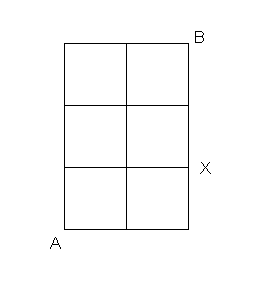Problem #3

An ant is placed on a 2 x 3 grid at the position marked X
in the figure below. The ant moves along the edges of the
grid as follows: from an intersection it randomly chooses
one of the edges emanating from that intersection and moves
along it, arriving at the next intersection one "step" later.
[Note that under these rules, the ant is allowed to
immediately double back on its path.] The points marked A and
B are exits. When the ant gets to one of them it leaves the
grid.

- Is the ant more likely to exit through point A or point B?
- On average, how long will it take the ant to exit the grid
(either through point A or point B)?
- If the ant is prohibited from immediately doubling back on
its path, how does this affect the answers to the two previous
questions?


